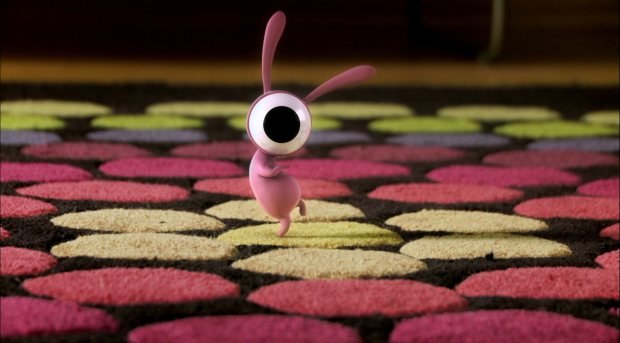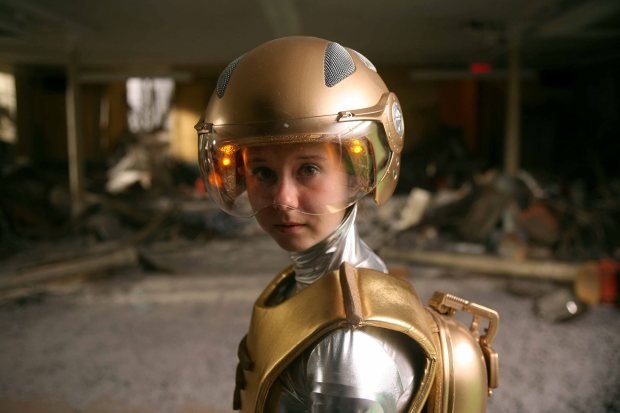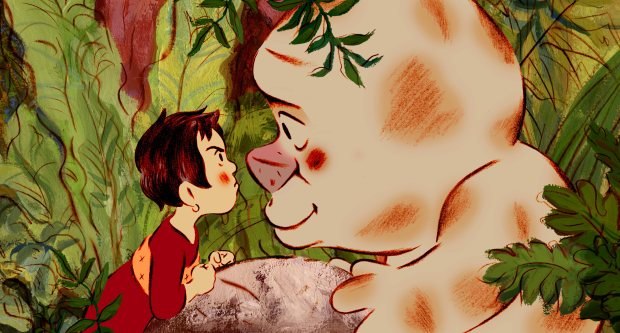The 2011 edition of the New York International Children’s Film Festival began early in March and wrapped on the 27th with its Awards ceremony, classy post-ceremony reception and traditional goodie-bag giveaway. If the fifteen-years and counting Big Apple fixture needed any more legitimacy, its newly won status as an Oscar-qualifying festival (NYCIFF prize winners now have a shot at the Academy’s golden statue) surely kicked it up a notch.
The 2011 edition of the New York International Children’s Film Festival began early in March and wrapped on the 27th with its Awards ceremony, classy post-ceremony reception and traditional goodie-bag giveaway. If the fifteen-years and counting Big Apple fixture needed any more legitimacy, its newly won status as an Oscar-qualifying festival (NYCIFF prize winners now have a shot at the Academy’s golden statue) surely kicked it up a notch.
Oh, to have the free time to attend all of the festival’s 17 programs. (Unfortunately, blogging has yet to pay the rent.) Eight animated (and one live-action) features competed for the feature film award, while dozens of shorts did likewise in their age categories. Instead, I had to settle for glimpses of the category finalists followed by a screening of the winning shorts.
Ormie, a pig who probably took lessons in frustrated obsession (in his case, a just-out-of-reach cookie jar) from Wile E. Coyote won in the ages 3-6 audience award category. The creation of David Steinberg, an animator at Starz’ Toronto studio, Ormie could easily carry an ongoing series, but as of this moment the porker’s a one-off. (A close up of a suction cup hitting the ground then pulling away was squash-and-stretch in its purest form.)
One of the category’s runners-up was an interesting throwback to animation’s earliest days: Robert Castillo’s The Yellow Balloon told the story of said-balloon’s peril-fraught trip stuck in a subway car door. The film consisted of a series of sketches drawn onscreen by Castillo (a New York-based storyboard artist), each timed to match a particular moment in the film’s narration. It reminded this festival-goer of cartoonists’ ‘chalk talks’ and old-timey cartoons focusing on the animator’s fast-moving hand drawing his characters. “I’m a big fan of animation history, Humorous Phases of Funny Faces, things like that,” Castillo explained. “I thought a film showing the process of drawing would be fun.” (Hint to anyone trying this at home: work on the overall forms first, save the facial features for last.)
Winner of the 5-to-10 category was Don’t Go, a CGI/live action film from Turkey focusing on a single-eyeballed little pink creature discoing away while eluding a persistent housecat.
Moving up to the 8-to-14 audience category, the winner was Marcel the Shell with Shoes On, a stop-motion effort featuring a tiny seashell explaining his lifestyle (lint on a thread for a pet, using a Dorito as a hang glider etc.). “We were both at a time in our careers, Jenny [Slate, voice of Marcel]especially where she was feeling sort of small,” said Dean Fleischer-Camp, the film’s co-creator. Marcel also snagged the Grand Prize Short trophy, a double victory that undoubtedly helped the pair feel a bit larger than their hero.
Pixels, a particularly bizarre piece of high-end CGI work won the 12-to-18 category, as New York and eventually the entire planet pixilated into a single enormous cube floating in space. Films like Pixels that combine CGI with hand-held, live action shakycam shots still amaze me, and it would be hard to top images like Tetris pieces falling from the sky and landing on a skyscraper’s setbacks. (Once all the setbacks were filled, the building’s entire section vanished, letting the floors above land on the lower ones with a thunderous, dust-raising crash.)
The Little Boy and the Beast, a sly tale that gradually reveals its secret: divorced parents can be beastly to one another won the Special Jury Award. (So that’s why the boy leaves his momma monster at regular intervals and climbs into a car driven by a second beast.)
Wouldn’t you know it: the feature film award was won by a live-action movie, Aurelie Laflamme’s Diary, besting four other live action and the seven animated features behind. All seven were unique and fascinating efforts, too rich and too many to detail here. (Clips, stills and more information can be found on the Festival’s website, www.GKIDS.com)
Two of the seven came from Folimage, a French animation studio. This year’s festival poster – a moody illustration of a cat posed against a crescent moon atop a gargoyle comes from A Cat in Paris, a crime story centering on the feline’s double life as a house pet and a gentleman jewel thief’s companion. The entire film is animated in the poster’s stylish, sharp edged look, courtesy of its co-director/production designer Alain Gagnol.
Paris’s co-writer/producer Jacques-Rémy Girerd also directed Mia and the Migoo, a kid-empowering, protect-the-environment fantasy centering around a sacred tree not unlike the one worshipped by Avatar’s Na’vi. The film’s gentle, watercolor backgrounds and friendly character designs (credited to one Benoit Chieux) couldn’t be more unlike Paris.
Migoo was the 2009 Festival’s opening night film – in its original French language version. It returned this year in a dubbed version produced and being distributed by GKIDS itself. It’s the company’s first shot at dubbing a feature-length film – a labor of love and a source of pride for Festival director Eric Beckman.
“We’ve dubbed a number of shorts for younger kids who don’t read yet. It’s easy to dub narrated films, we’ve been doing that for a couple of years. Sometimes a really wonderful subtitled film is completely destroyed by a dub, or the dubbing is just okay but something’s lost. We kind of wanted to try our hand at dubbing a feature.”
Migoo features voice work from Whoopi Goldberg, Matthew Modine, Wallace Shawn and James Woods, not to mention John Di Maggio, best known as Futurama’s Bender. “We wanted a balance between name actors who could help the film in terms of publicity, but we really wanted to be true the characters in the film; we cast in terms of who would be best [voices for the] characters.
“ADR work is hard, harder than I think actors are used to. We put them in the booth and have them do the line again and again. It’s not like animation that’s going to be done to the voice where you get it in two or three takes. We had people doing literally 20 takes to get a grunt – ‘can you do one less exasperated and more tired?’ Or ‘the character’s moving – can you do the same grunt but add a little ‘unh’ into because you’re lifting something?’
“It’s amazing what people would go through. We’d say because there’s some physicality to this, ‘do two jumping jacks, two push-ups, do a circle then say your line before you finish spinning.’ They’re in there working very, very hard.
“Everyone recorded their lines to picture, except Whoopi [as a mysterious and eccentric sorceress]. She was funny, really great in the film, but she insisted on doing her lines without looking at the movie. When she came in I said ‘I want to tell you a little bit about the character.’
‘No, I read the script. I don’t want to hear about the character.’
‘Would you like to see the French performance of the character?’
‘No, I don’t need to see the French performance. I’m just going to go in the booth and do it.’
‘The picture’s going to be up there, you’ll hear 3 beeps –’
‘No I don’t want to look at the picture.’
‘How are we going to match the sync?’
‘That’s how I want to do it.’
We scratched our heads and kept her in there. We did take after take and she was really, really good. Michael Sinterniklaas who directed the ADR said it was one of the toughest editing jobs he had because he had to make her great acting fit those lips of the sorceress. When she’s in close up she fills two-thirds of a 40 foot screen – there’s no faking it. If you’re saying an ‘f’, it’s an ‘f’ onscreen, and if you’re saying ‘oooh’ your mouth is a big circle. Between the two of them they did a great job.”
Now that GKIDS has moved up from dubbing shorts to an entire feature, does Beckman see the company dipping its toe into actual production?
“It’s emboldened us a little. What I don’t see us doing is taking $50 million risks on movies. I think where films are being created for European or Asian markets or an international co-production, we can be involved early on. The nature of indie animation production often involves compromises: it’s a big struggle to patch funding together, with a co-finance deal here and tax support there. All of a sudden you do a final sale to German TV; now you’ve got a deadline and you’ve got to hit it. That’s when the compromising begins.
“I’m a big believer in 2D animation, in a variety of styles. I think it’s an expressive art form. I would like to see more films made for $5-15 million dollars that could work for a range of audiences.”
That’s down the road; in the meantime Eric and GKIDS will be busy working on commercial distribution for films like Mia – not to mention gearing up for the 2012 edition of the New York International Children’s Film Festival.










